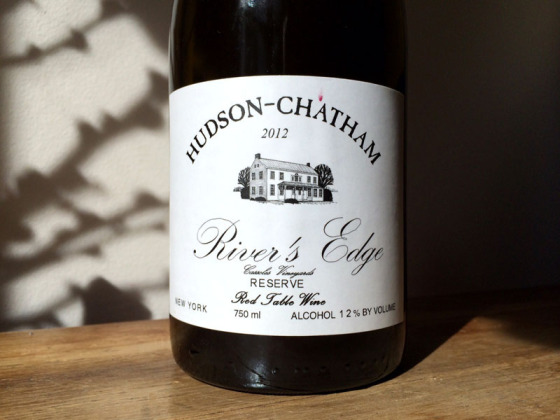Many wine lovers turn their collective noses up at wines made with hybrid grapes. While obscure varieties from dark corners of European countries are sought out and embraced, grapes like Corton Noir, De Chaunac, Frontenac, Marechal Foch, Traminette and La Crosse are shunned.
I’d be lying if I told you I was, generally, a fan of hybrid wines, but I do have one thing that many wine lovers don’t have — an open mind. I’ll try any wine made with any grape (or fruit really) once. Okay, maybe even twice. There are hybrids that I don’t care for very much (I’m looking at you Traminette and Seyval Blanc) but there are some that I’ve enjoyed quite a bit, including Vidal blanc, Leon Millot, Vignoles and Baco Noir.
Baco Noir, of course, is the focus at one of the better wineries in the Hudson Valley — Hudson-Chatham Winery — and while Hudson-Chatham Winery 2012 River’s Edge ($) isn’t made with baco, it shows winemaker Steve Casscles’ deft touch with red hybrids in the cellar.
River’s Edge is a 50-50 blend of Chambourcin, a well-known red hybrid grape that can lead to some spicy, delicious wines, with Burdin, a hybrid that I’d never tasted before. What is Burdin, exactly? The following is taken from the Hudson-Chatham website:
The vines themselves came from Philip and Jan Wagner, of Monkton, Maryland. Philip Wagner was the editor of the Baltimore Sun for many years, and the owner of Boordy Vineyards. He also sold French-hybrid vines from a nursery with his wife. Mr. Wagner, before the arrival of Dr. Konstantin Frank, practically saved east coast winemaking by offering these vines that were more suited for the region at the time. Wagner had imported the vines from France.
According to the notes on the Wagners’ vineyard brochure, “We introduced the French Hybrids commercially in this country more than three decades ago. Vines originating in our nursery are today yielding good wines in almost every state of the Union. Several of the hybrids have already become standard wine grapes in the older grape-growing districts such as New York State and Ohio. The family of the French Hybrids is large and varied: early ones for the more northerly regions, some that stand up under humid conditions and severe winters, others for hot dry climates, and so on. It is possible to choose with reasonable assurance for most parts of the country. But remember, the finest grape varieties and the famous vintages of Europe have behind them several thousand years of selection and adaptation and centuries of winemaking experience. You can expect to produce very good wine from the hybrids, but do not expect to equal the “great” wines of Bordeaux or Burgundy or Chablis.”
As a young grape growing enthusiast, Steve Casscles met the accomplished and insightful Philip Wagner when Steve was still in his high school and college years. Before Wagner closed his vineyard supply business, Steve Casscles plucked numerous vines from Wagner, who was always ready with advice and good cheer. Wagner always intimated to Casscles that the Burdin grape was a sleeper. Now we grow almost two acres of it. Steve Casccles grows two varieties of Burdin. He grows Burdin 8753 (An early mid-season. Pinot Noir hybrid with oderate vigor and productivity, in combination with short cane pruning; and Burdin 11042 which is an early mid-season ripening hybrid of Pinot Noir Droit with good vigor, moderate production, is fairly disease resistant, and to be grown using cane pruning.
Burdin’s pinot ancestry is obvious in the glass too, where aromas of black cherry and cherry Ludens are accented by a toasty vanilla note. On the palate, it is lighter bodied and the toasty notes step forward just a bit, with sweet cherry and a melange of woodsy, earthy spice notes. Fresh acidity brings structure (the tannins are very light) and juiciness that leads in to a somewhat abrupt finish.
Mostly I dislike comparing New York wines or wine regions to classic wines or regions, but without a ton of context in the hybrid arena, I’m left thinking of Hudson-Chatham’s reds as Burgundian. It’s not so much where the wines are today as where you can tell they are going. Delicacy and freshness are valued over extraction and brute force.


